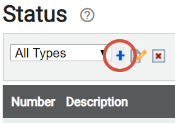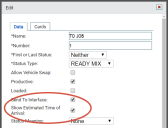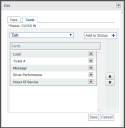Settings > Status > Status
The processes and workflows associated with your company may be broken down into statuses. These specify the activity your driver must complete or is currently doing, while also allowing dispatch to monitor jobA project that orders and tickets are grouped under. progress and resource allocation.
Creating a Status Type
Each Equipment Type should have its own statusThe specific activity or task a driver is currently engaged in, typically as part of a process called a "status loop." type because they each have their own processes. Once a status type is created, you may then create statuses based on the processes followed by your vehiclesAll machines used as a means of production on a construction site or at a batch plant..
|
The name that best describes the status type, such as the work type or vehicleAll machines used as a means of production on a construction site or at a batch plant. type associated. For example, a company might create separate types for Ready-Mix and Bulk Hauler vehicles. |
|
|
Only the next status in the loop may be selected when manually changing statuses. This prevents administrators from giving a range of statuses that may be selected by the driver at any point in the loop, such as lunch. |
Additional functionality such as a Status Action allows for greater streamlining of your jobs by associating a behavior with the status, such as Start Ticket with the Clock In status.
Different status types might include a status unique to a vehicle's processes. For example:
- Ready-Mix trucks use Pouring.
- Water trucks use At Fresh Water Pickup.
- Hauler trucks use Dumping.
The Add Status Type dialog windowA pop-up window that requires user input. appears.
- Enter a Description. This label typically mirrors the associated Equipment Type for ease of assignment.
- Select Enforce Status Restrictions if you wish to ensure drivers follow a logical path of actions on the TrackIt Android app. A Status Restriction must exist for this functionality to work.
- Click Save
 .
.
Creating a Status
Adding a status allows you to specify behaviors, payroll settings, threshold timers, and cards to display on the TrackIt Android app.
Data tab
|
The name of the status typically indicates the activity associated, such as Washing, Loading, or To Job. |
|
|
The status's numeric orderIndividual requests for specific materials that are associated with a job. Some jobs may consist of multiple orders of varying products. in the status loopA series of statuses that constitute the typical process a driver should progress through as part of their daily duties. itself. This value helps identify when a status is encountered by the driver as they progress through the tasks associated with a job. You may only assign one status to a number. Attempting to assign a number already in use will result in a pop-up alert.
|
|
|
The first and last statuses in a loop, such as Clock-In, In Service, Pre-Trip, or Post-Trip indicate to TrackIt how their order should be treated. You may only have one status marked as FIRST STATUS and LAST STATUS at a time. Unassign the existing status(es) to replace them with another first or last status.
|
|
|
The status loop to associate with the status, often based on the type of vehicle being used. This governs what types of statuses are available for selection with regard to the next or previous status. |
|
|
If selected, the driver may perform a vehicle swap and then continue through the status loop. Users must manually restart the status loop if they swap vehicles otherwise. |
|
|
When tracking employeeUser accounts for drivers, dispatchers, and other staff to perform varying functions in TrackIt. performance and productivity, this option flags the time spent in this status as measurable toward material per hour. The data collected in this status is then used in the Material Per Hour report. |
|
|
Flags the status as no longer loading, but fully-loaded for a trip. If your company is integrated with a supported service like COMMANDseries via (Undefined variable: 5c-main.trackit-trackitware), this flag is included in data reporting with the service. |
|
|
If your company is integrated with a supported service like COMMANDseries or BuildIt via (Undefined variable: 5c-main.trackit-trackitware), this setting ensures that the status is included in data reporting with the service. |
|
|
The time it will take for a vehicle to reach its ticketShort for “delivery ticket,” which is printed and given to the driver. Also called a tag or docket. The ticket includes, at a minimum, the product(s) ordered and the delivery address. It can also include the amounts of materials batched to form the mix. In the past, producers sent copies of the delivery ticket with prices as invoices; now tickets and invoices are two separate documents. destinationThe location of a job or pour site that a driver must navigate to. displays on vehicle rollovers when selected. From the Equipment Map, each time a vehicle icon is clicked or hovered over, its destination ETA (estimated time of arrival) shows beneath the equipmentAll machines used as a means of production on a construction site or at a batch plant. name. This value indicates the total amount of time remaining for the vehicle to get from its current location (based on GPS fixCoordinates for a vehicle's location. These are fetched by TrackIt at regular intervals to map equipment routes over the course of a day.) to the job destination. For this feature to function properly, the driver must have an Active status ticket with a Destination Address. The ETA will only display when a driver is heading to a destination, not for return trips to plants.
|
|
|
When status names are unusual, this drop-down effectively defines its meaning. This then helps third-party solutions to understand how to handle this status with any associated actions or behaviors. If your company is integrated with a supported service like COMMANDseries, HaulIt, or BuildIt, this meaning is included in data reporting with the service. |
|
Payroll Settings |
|
|
For payroll purposes, this option ensures that all time spent in this status is billed as payable time on an employee's time cardA log of an employee's start and quit times. The time card collects both the scheduled and actual times captured via TrackIt.. |
|
|
Time spent in a status flagged with this option ensures that this time is tracked as lunch on a time card for payroll logging. If this is a designated lunch period, make sure that the Paid option is deselected. |
|
|
This is used for payroll purposes with an integrated solution. |
|
|
Acct. Code 2 |
This is used for payroll purposes with an integrated solution. |
|
The amount of time allowed for staying in this status before the TrackIt Android app forces the user to the next status automatically. This is often used for washing or loading vehicles to encourage time efficiency and ensure users are actively completing steps in the loop. |
|
|
The next status in the loop that the user is changed to once the threshold is exceeded. Companies often set this to simply change to the next status in the loop, whereas others might set it to default to a status indicating a delay to the progress of completing a ticket. All statuses currently available for the assigned status type display here. |
|
|
When the Threshold Time elapses and the user is automatically changed with the Threshold Status Change, TrackIt Android displays a messageText messages exchanged between drivers and dispatchers using TrackIt. alerting the reader of the system change to status. |
|
|
The color associated with the status when viewing the Equipment Map, Employee Dispatch, and Equipment Dispatch screens. |
|
Cards tab
The appearance of the TrackIt Android app may be customized with Status Cards, such as ticket data, to-job navigation, and hours of service. Multiple cards may be included on each screen, though it may require the driver to swipe the screen to see all card information.
- Navigate to Settings > Status > Status.
- Click the Add New Status
 button to create a new status.
button to create a new status. - From the Data tab, provide values for the Name, Number, First or Last Status, and To create a status type fields.
- Click on the Cards tab to include Status Card on the Android app while in this status.
- Select the desired card from the drop-down menu and click Add to Status
 .
. - If you've chosen multiple cards, click the arrow

 buttons to reorder how they'll appear on the tablet screen.
buttons to reorder how they'll appear on the tablet screen. - Click Save
 .
.











